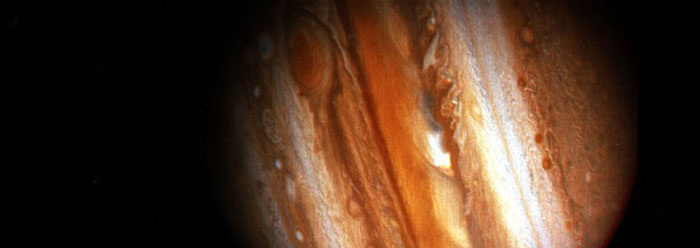More recently, astronomers conjured an unknown massive planet that was supposedly responsible for placing Uranus and Neptune in their unique paths around the sun. However, the fictional planet is still a woefully insufficient cause for today's planetary orbits.
The extra planet was proposed because cosmologists have had a miserable time trying to model the evolution of the solar system's four gas giant planets from a huge, unorganized dust disc.2 The recent modeling effort, partly funded by the National Science Foundation, defined a "successful" attempt very loosely.
First, the outcome had to result in four giant planets that correspond to the four outer gaseous planets, Jupiter, Saturn, Uranus, and Neptune. So far, that makes sense.
But second, the four planets in the model only needed to have orbits that merely resembled, rather than exactly matching, those of the real planets. And the study's resemblance tolerances were broad. For example, the researchers only required the semimajor axis [the longest radius of an orbit] of each resulting planet to be "within 20% to its present value."3
Third, since they had such poor luck achieving Jupiter's current amplitude, the scientists settled for "at least half of its current value." The study's author wrote, "The overall success rate for the criterion C [achieving the correct amplitude] was disappointingly low," even with that extra fifth fictional planet added to the simulations.3
The fourth condition specified the orbital periods of Jupiter and Saturn. However, the formation of these was difficult, if not impossible, to model. "This condition may therefore require planetary encounters, but is more subtle in that not all simulations with Jupiter encounters are good," according to the technical report.3 The researchers imagined that the fifth planet had encountered and displaced Saturn and Jupiter into their present orbits.
The proposed fifth planet was declared "promising," but the study author never clearly asserted that it provided a solution for all four criteria—or even one of them. And even if it did, the defined criteria were not up to the standards of the solar system's true structure, which just "happen" to be perfect for life on earth.4 (For example, the outer gas giant planets act as massive gravity-acting "vacuum cleaners" that scour much incoming debris from outer space before it penetrates deeper into the part of the solar system where earth resides.)
Since no combination of natural factors, even with the addition of imaginary planets, can result in the known solar system, it must have been created by intent and not accident. If anything, this solar system simulation perhaps unwittingly confirms the Genesis account of creation, in which God purposely made the "lights in the firmament of the heaven" on Day 4 of the creation week.5
References
- Thomas, B. New Comet Origins Idea Adds New Problems. ICR News. Posted on icr.org December 9, 2010, accessed September 29, 2011.
- Coppedge, D. 2008. Nebulous Hypothesis. Acts & Facts. 37 (2): 15.
- Nesvorny, D. Young Solar System's Fifth Giant Planet? arXiv:1109.2949v1. Posted on arxiv.org September 13, 2011.
- Bergman, J. The Earth: Unique in All the Universe (Updated). Posted on icr.org February 2008, accessed September 29, 2011.
- Genesis 1:14-18.
* Mr. Thomas is Science Writer at the Institute for Creation Research.
